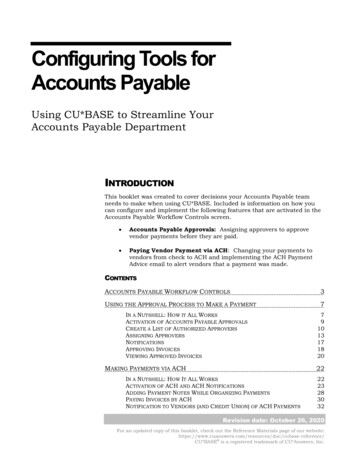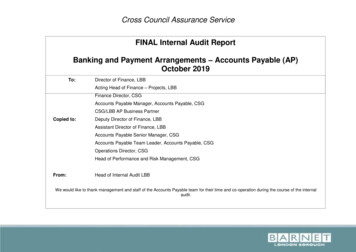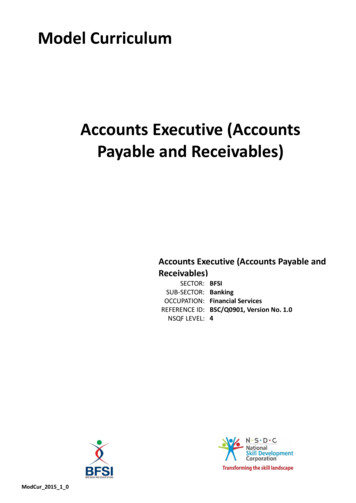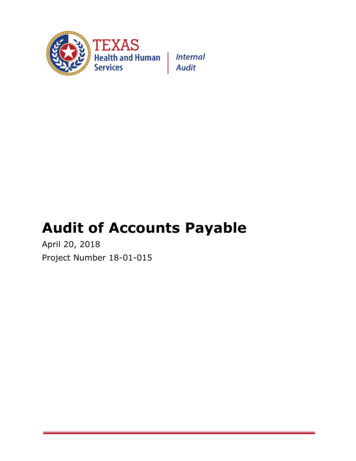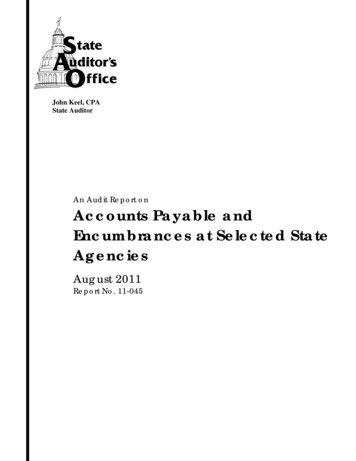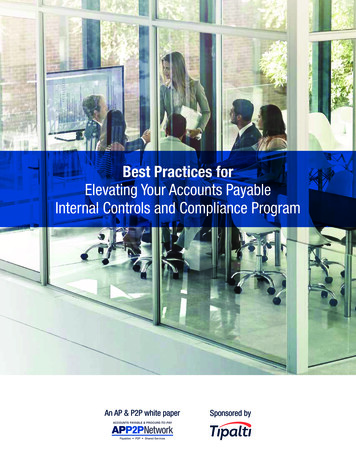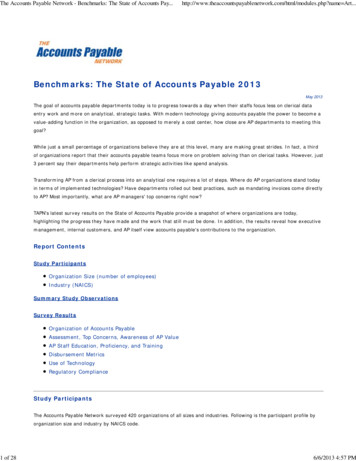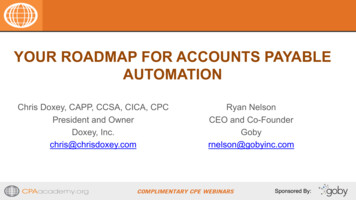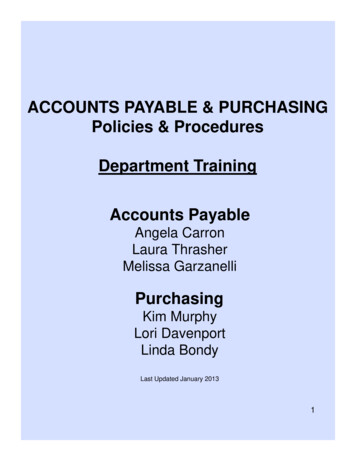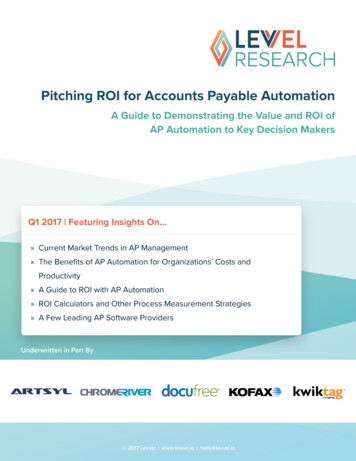
Transcription
Pitching ROI for Accounts Payable AutomationA Guide to Demonstrating the Value and ROI ofAP Automation to Key Decision MakersQ1 2017 Featuring Insights On.»» Current Market Trends in AP Management»» The Benefits of AP Automation for Organizations’ Costs andProductivity»» A Guide to ROI with AP Automation»» ROI Calculators and Other Process Measurement Strategies»» A Few Leading AP Software ProvidersUnderwritten in Part By 2017 Levvel www.levvel.io hello@levvel.io
Pitching ROI for Accounts Payable Automation Q1 2017ContentsIntroduction 3Defining AP Processing Pains 4The True Cost of AP 8Measuring Success 14Artsyl 15Case Study: Canac Inc. 17Chrome River 19Docufree 22ImageTag 25Case Study: CCA Global Partners 28Kofax 30About Levvel Research 33Hello@Levvel.io 980.278.3065 2017 Levvel All Rights Reserved 2
Pitching ROI for Accounts Payable Automation Q1 2017IntroductionWhen it comes to improving an organization’s back office, AP automation is oneof the most effective methods of streamlining inefficient processes, reducingprocessing costs, and providing more visibility into and control over supplierinvoices and payments. Landmark AP automation tools like electronic invoicing,invoice approval workflow, and supplier management portals have helpedmany companies eliminate paper and reduce processing pains, including latepayments, invoice errors, and missed discounts. With an automated AP process,organizations have the potential to save millions of dollars in processing costseach year.However, this story of AP transformation, while true for many companies whohave implemented a system, is not always effective in persuading key decisionmakers to adopt a solution. Levvel's research shows that the top barriers toinvoice management software adoption include the belief that current processesare working, a belief that there will be no Return on Investment (ROI) from asolution, and a failure to gain internal buy-in. These three barriers often keeporganizations operating with manual processes for many years. Instead, theycontinue to overspend on processing costs and miss out on potential savingsfrom early-payment discounts.This report is intended to help organizations understand the value of APautomation and communicate that value to key decision makers. This reportincludes several helpful tools for practitioners making the case for an investmentin AP automation. It explores different scenarios of an AP state before and afterautomation, and includes calculators to help practitioners demonstrate ROI toany stakeholder.Hello@Levvel.io 980.278.3065 2017 Levvel All Rights Reserved 3
Pitching ROI for Accounts Payable Automation Q1 2017Defining AP Processing PainsWhen preparing to make the case for automation to company stakeholders anddecision makers, the most important element to include is the metrics of thecurrent state. This includes not only the current state of the organization’s APprocess, but also the current state of the market as a whole. It is important tounderstand how other organizations are faring in their back offices in order tobuild perspective—and show room for improvement.In order to identify invoice management trends among North Americanorganizations, Levvel Research surveyed over 300 back-office employees acrossseveral industries and market segments. Research shows that organizations’top pains in their invoice management process include manual invoice routing,manual data entry, and high volumes of paper invoices, see Figure 1. Theseissues and others, such as lost invoices and a high number of invoice exceptions,are all common symptoms of a manual AP process.FIGURE 1Top Challenges in the AP ProcessManual routing ofinvoices for approval25%Manual data entry andinefficient processes23%Majority of invoicesreceived in paper format18%9%Lost or missing invoicesLack of visibility intooutstanding liabilities8%Decentralized invoice receipt8%High number of discrepanciesand exceptionsInability to approve invoicesin time to capture discounts7%2%Organizations’ Top AP Pains Concern Manual Routing and Data Entry, and High Paper“What are the top three biggest pain points you experience in your AP workflow process?”Hello@Levvel.io 980.278.3065 2017 Levvel All Rights Reserved 4
Pitching ROI for Accounts Payable Automation Q1 2017Another side effect of manual processes is a high volume of missed discounts,often due to the lack of visibility into invoice lifecycles and the resulting latepayments. For many organizations, missing discounts is a familiar experience.When asked how often they were able to capture early payment discounts, mostorganizations reported “sometimes,” see Figure 2.FIGURE 2How Often Organizations are Able to Capture Early Payment DiscountsAlways (33%)Sometimes (51%)Never (16%)One-Half of Organizations Only Capture Discounts Some of the Time“How often is your organization able to capture early payment discounts on invoices?”If an organization were to use an AP solution that sped up invoice lifecycles andoffered an option for suppliers to designate discounts on their invoices, it couldincrease discount capture anywhere from 5 to 35 percent. This could result inmillions of dollars in savings, depending on an organization’s size and annualinvoice volume. Organizations with manual AP processes often miss these savings.Manual-based AP processes reduce an organization’s profitability in other areasas well, such as in dispute management. With a manual process, organizationsare more likely to experience invoice errors, duplicate invoices, late payments,and unhappy suppliers. The time required for AP staff to handle invoice andpayment disputes can add up, and some organizations are spending thousandsof dollars each year solely on damage control. Table 1 contains calculations oforganizations’ labor costs for dispute management, assuming an average annualsalary of 45,000 per AP staff member, three weeks of PTO, two weeks ofcombined holiday and sick leave, and a 20 percent overhead calculation.Hello@Levvel.io 980.278.3065 2017 Levvel All Rights Reserved 5
Pitching ROI for Accounts Payable Automation Q1 2017TABLE 1Annual AP Issue Resolution CostsHours Spent Each WeekAnnual Costs Per Employee1-3 1,350 – 4,0504-8 5,400 – 10,8009-20 12,150 – 27,000These issues are the most common reasons why organizations adopt an APautomation solution. What happens with a fully automated invoice managementprocess? Organizations see tremendous improvements in their ability to processinvoices efficiently, on time, and with very few exceptions. Research showsthat the top improvements organizations experience after automating APprocesses are quicker invoice approvals, increased employee productivity, lowerprocessing costs, and increased visibility, see Figure 3.FIGURE 3Top Improvements Gained Through AP Automation25%Quicker approval of invoicesIncreased employee productivity19%Improved visibility over liabilities18%Lower processing costs18%Better compliance with regulatoryrequirements (SOX, FASB)Reduction in late paymentpenalties and interest11%9%Organizations Experience Improvements in Cycle Times, Productivity, Costs, and Visibility“What are the greatest improvements you have seen since implementing an invoice workflow solution?”When practitioners make the case for automation, they should be sure tocompare these market trends to their own company’s processes, identifying anysimilar pains and lost savings opportunities. With a clear picture of its current,inefficient AP state, an organization’s leadership can better imagine a future,optimized state—one in which it is reaping the benefits of an automated AP process.Hello@Levvel.io 980.278.3065 2017 Levvel All Rights Reserved 6
Pitching ROI for Accounts Payable Automation Q1 2017Once decision makers understand the value of AP automation in general, itis important that they see the effects a solution can have on their company’sspecific business structure and AP department. The following section providessome real-world scenarios that organizations can use as a model to determinethe costs and savings possible with an AP automation solution.Hello@Levvel.io 980.278.3065 2017 Levvel All Rights Reserved 7
Pitching ROI for Accounts Payable Automation Q1 2017The True Cost of APWhen adopting AP automation, the success of a company’s adoption initiativewill often depend on its previous experience with AP automation—and backoffice technology in general. In some cases, a practitioner could be making thecase for software adoption to a company that has never automated any majorback-office process with a software tool. In others, an organization could alreadyhave an AP software tool in place. It could be an outdated solution or one thatwas unsuccessful in improving processes, leading the practitioner to encouragethe company to replace the tool.An organization’s experience with automation can vary based on many factors,including the company’s size and age. For example, an organization that wasfounded over 40 years ago is much more likely to have several software toolsimplemented in back-office departments, whether an HR solution, a payrollsystem, or one or more ERPs. Older organizations are more likely to haveadopted their ERP’s on-premise financial automation tools, as these offeringswere reaching prominence among ERP providers in the 1990s and early 2000s.Larger organizations are also more likely to have already adopted an AP system,as they have more financial resources to adopt a solution—and will feel fewereffects of a financial loss if the solution is not an successful fit.There are advantages and disadvantages to automating an AP processcompletely from scratch. For example, if a company is not dependent on legacybased AP automation, they typically lack an established relationship with theIT department, which can add more time to the adoption and implementationprocess. They will also more likely need to hire additional internal IT resources toassist with implementation. On the other hand, the company will have the abilityto design and customize a completely new automation process without worryingabout interacting with existing solutions and hardware.There are also advantages and disadvantages when a company already has anERP/legacy AP system in place. If the company decides to replace their system,they will have to sever their existing software contract, as well as reallocate ITroles that were monitoring the existing solution. They will also have to considerhow to integrate the new solution with existing processes and hardware (e.g.scanners). However, the company will have the benefit of established personnelto manage the implementation, which entails a team that already possesses localIT and process knowledge. In addition, the company will have a back-up solutionin case implementation goes wrong.Hello@Levvel.io 980.278.3065 2017 Levvel All Rights Reserved 8
Pitching ROI for Accounts Payable Automation Q1 2017No matter what experience a company has with financial process technology,the best tools that a practitioner can employ when making the case for APautomation are the numbers. From decades of consulting and market research,Levvel Research has been able to estimate general costs of implementationand the criteria to use when evaluating the potential ROI of a tool. The followingitems cover some of the potential costs—and savings—involved in softwareimplementation and process changes, and are meant to help organizationsestimate these cost areas in their own processes.Initial Cost of Implementing Automation»» Implementation Costs – Most providers charge a certain percentage oftheir subscription fee up front, though this varies by provider. To predictimplementation costs, organizations can reach out to a few providers torequest estimates.»» The Cost of Downtime and Evaluation – In cases where organizations arereplacing an existing AP automation system, they should consider the timeduring which they will have to take their current tool offline. This may resultin some missed discounts or higher labor costs when the solution is nothandling all processes, and these costs should be quantified and considered.Organizations implementing their first major AP tool or a replacement toolshould factor in the cost of consultants, who usually bill at an hourly rate.Potential Savings from Process Automation»» Optimized Labor Costs – AP automation allows many organizations torestructure their AP department. This entails reallocating staff members thatnormally take care of low-value tasks, such as manual data entry, to other,more strategic positions. Sometimes automation simply takes the pressureoff of an over-burdened team; an inefficient AP process often forces an APstaff to spend their time fixing issues that should not have happened in thefirst place, such as tracking down missing paper invoices. Research showsthat two-thirds of AP staff spend between 1 and 8 hours each week resolvingAP issues, see Figure 4.Hello@Levvel.io 980.278.3065 2017 Levvel All Rights Reserved 9
Pitching ROI for Accounts Payable Automation Q1 2017FIGURE 4Time Spent Resolving AP Process Issues1-3 hours per week36%4-8 hours per week35%9-20 hours per week14%NoneIt is my job to resolve these issuesOver half my time8%4%3%Many AP Professionals Spend Several Hours Each Week Resolving Process Issues“How many hours each week do you estimate you spend on resolving AP process issues? (invoice errors, duplicateinvoices/payments, supplier calls, etc.)”If these hours are reduced with an AP solution and employees can focuson more important activities, organizations gain much more value fromeach dollar of labor spent. Organizations should calculate the effects APautomation would have on their own resolution times and labor costs.Example 1 illustrates the savings in labor costs if an organization were toeliminate a few positions after automation.EXAMPLE 1Assumption:An organization employs 5 full-time AP clerks making an average of 38,000 per year. In a manual process, each clerk processes 20 invoicesand handles 5 vendor inquiries per day.Result:With an AP solution, this workload is reduced to one vendor inquiry per day,and AP clerks only manage exceptions—an average of 2 exception invoicesper day. This allows one person to handle the work of five people, enablingthe organization to reassign 80 percent of their AP clerks, and saving a totalof 152,000 a year in labor costs attributed to AP.»» Many times, organizations can reallocate staff to more strategic, valueadded activities. AP automation also brings the ability for a company togrow without needing to significantly expand their AP staff. For example, ifa company with a mid-single-digits growth rate and spend growing at 80Hello@Levvel.io 980.278.3065 2017 Levvel All Rights Reserved 10
Pitching ROI for Accounts Payable Automation Q1 2017percent of that rate were to expand, it should be able to calculate the annualsavings of an AP solution across their labor costs.»» Mailroom Processing – Not all organizations have a designated mailroom,but for those that do, these operations can be very expensive in terms oflabor. Eliminating paper invoices with an AP automation solution can reducethe staff hours needed to process the mail, but only to a certain degree.When evaluating these costs, the practitioner should assume that 30 percentof mail is AP-related, and factor this amount into the reduction of mailroomstaff.»» Data Entry Labor and Equipment – Many organizations with high volumes ofpaper invoices must perform a great deal of manual data entry to input andprocess invoices. This is usually handled either by AP clerks or a separatedepartment designated to AP data entry. In the latter case, professionalsare typically fully allocated to AP and do not transfer across departments.This means that when data entry is eliminated, the organization saves all ofthose costs (unlike with mailroom processing). The data entry process alsorequires the use of scanners, which can be very expensive at the industriallevel. Example 2 shows what happens when an organization implements anAP automation solution with electronic invoicing and eliminates data entryentirely.Assumption:An organization employs 4 full-time data entry clerks with an average annualsalary of 33,000. The organization has three scanners, purchased at 5500per scanner; the scanners have a 2-year lifespan.Result:If the organization eliminates the data entry department, also removing thelabor costs and the need to repurchase scanners at the end of their lifespan,the company would save 693,000 in 5 years.»» Increased Discount Capture – With an AP automation system, processes arestreamlined and invoice lifecycles are shortened, meaning that organizationshave a much greater ability to pay invoices early and capture early paymentdiscounts. The monetary savings depends on the number of invoices anorganization receives and the percentage of those invoices that are eligiblefor discounts. Levvel Research has found that most companies are offereddiscounts on 20 percent of invoices (or 20 percent of spend).Hello@Levvel.io 980.278.3065 2017 Levvel All Rights Reserved 11
Pitching ROI for Accounts Payable Automation Q1 2017Assumption:A middle-market organization has 300 million in annualspend. With a manual AP process, the company is offereddiscounts on 20 percent of their annual spend, and it isable to capture 5 percent of those discounts with averagediscount terms of 2/10 net 30. This results in approximately 60,000 in annual savings.*Result:After the company automates its AP process, the discountcapture rate rises from 5 percent to 80 percent on eligiblespend. This results in approximately 960,000 in annualsavings.**Ceteris paribus to supplier segmentation and invoice size.Other Potential Process Improvements»» Cost of Capital – An AP automation solution can dramatically improvemany aspects of processes throughout an organization, including supplychain operations. Automation improves payment times and vendorrelationships, and can also affect an organization’s credit and eligibility forloans. While these benefits are harder to quantify than some other processimprovements, organizations should still consider the effect a solutioncan have on their cost of capital when making an investment decision. Forexample, operating under a hypothetical credit rating improvement, howwould a company’s business plans change in the next 10 years?»» Improved Month/Quarter/Year-End Close Processes – This unavoidable,time-consuming process can be simplified and made far more efficient withan AP solution. With the automatic reconciliation and auditing capabilitiesprovided by many AP solutions, accounting professionals gain much morevisibility into the closing process. This reduces the stress of the process forthe accounting department and could eliminate the need to hire outside helpduring these busier times.»» Elimination of Outsourcing – Not all organizations outsource, but many findit easier or more affordable to send their invoice processing, routing, and/or payments to outside teams. However, AP technology can completelyeliminate many of the manual activities that organizations outsource,using technologies like electronic invoicing, online data capture tools,machine learning, and automatic approval workflows. This immediately anddramatically reduces annual AP costs.Hello@Levvel.io 980.278.3065 2017 Levvel All Rights Reserved 12
Pitching ROI for Accounts Payable Automation Q1 2017»» Document Storage – Many AP solutions allow organizations to store theirinvoices and other business documents in an electronic archive. Thiseliminates the need for physical storage containers. Depending on the sizeof the company and the volume of retained documents, this could free upconsiderable extra office space—it may even prevent or postpone a movefor a growing company. Eliminating paper also reduces the risk of losingvaluable business data in the case of unforeseen circumstances, such astheft or fire.Hello@Levvel.io 980.278.3065 2017 Levvel All Rights Reserved 13
Pitching ROI for Accounts Payable Automation Q1 2017Measuring SuccessWhen practitioners are preparing for their presentation, they should have asmany measurements to consider as possible. Table 2 contains a few calculationsthey can use to determine real ROI results.Total Cost Per Invoice(Number of AP Clerks * Average Annual Salary) / Number ofAnnual Invoices (does not account for overhead or other softcosts)Perfect Payment IndexCalculation% electronic * % paid on-time * % discount achievedFirst Year ROI (%)Annual Savings / Total Cost of ImplementationPayback Period (Years)Total Cost of Ownership (Annual Subscription* Number of Years Implementation Cost) / Annual Savings5-Year ROI(Annual Savings * 5) / (Total Cost of Ownership 5 YearMaintenance Costs)In order for an automation overhaul to be successful, it is vital that seniormanagement understand the value, need, and primary use of the software.When presenting their case for automation, practitioners should leverage allcurrent-state and ROI metrics with a detailed plan for product implementation,highlighting the long-term benefits of the solution in both hard and soft costs.This will ensure that stakeholders are aware of their process needs, educated onthe solutions to these needs, and optimistic and enthusiastic about implementinga new system.The following profiles highlight the features of a few leading AP providers.Each of these providers has a track record of helping clients optimize their APprocesses to produce the highest possible ROI and long-term success.Hello@Levvel.io 980.278.3065 2017 Levvel All Rights Reserved 14
Pitching ROI for Accounts Payable Automation Q1 2017ArtsylArtsyl has offered software for intelligent document capture, workflowautomation, and invoice management for over 15 years, releasing its invoicesolution, InvoiceAction, in 2013. Artsyl offers InvoiceAction along with its flagshipproduct, the docAlpha Smart Process Platform, to enterprises of all sizes in avariety of industries, including shared services providers. The company helpsclients process millions of documents each year across a variety of types,including invoices, medical claims, and government documents.Founded2001HeadquartersTorontoOther LocationsKiev, TampaNumber of Employees51Number of Customers500 Target VerticalsCorporate Finance, Manufacturing, Financial Services,HealthcarePartners / ResellersSAP, docSTAR/Epicor, ReQlogic/UXC/CSC, AcumaticaSolution OverviewArtsyl partners with Microsoft, and its products are developed using Microsoft.NET and Services Oriented Architecture; Artsyl also has adopted and followsall standard security models from Microsoft. Artsyl’s products leverage tightAPI-based integrations with major ERP systems such as SAP, Oracle/NetSuite,Microsoft Dynamics, Acumatica, and integrate with even more using webservices. InvoiceAction is available in English, French, German, Spanish, andRussian. The product supports OCR data capture for over 100 languagesincluding Arabic, Thai, Hebrew, and Vietnamese.InvoiceAction and docAlpha automate many of the most painful steps in invoiceprocessing—manual data entry, approval routing, matching, and GL coding. Thesesolutions allow customers to scale their AP operations without adding staff, whilesignificantly reducing processing cycle times. These customers gain better visibilityinto cash flow and control over the process, and higher early pay discount capture.Artsyl’s solutions use a transaction statistics server to collect and report on allfacets of any transaction processed through the system. The solutions offerreports that can be configured to present all possible KPIs for a client. Artsyl’sconsulting staff works with all clients to map out the current processes and reengineer them leveraging docAlpha and InvoiceAction’s features.Hello@Levvel.io 980.278.3065 2017 Levvel All Rights Reserved 15
Pitching ROI for Accounts Payable Automation Q1 2017Invoice ManagementArtsyl’s docAlpha solution can extract data from any digital and paper documentwith intelligent capture technology, and leverages InvoiceAction to handle a specificbusiness document flow—vendor invoice processing. docAlpha validates capturedinvoice data using its own algorithms and by cross-referencing information againstclients’ ERPs or other business systems. docAlpha then applies business rules toextracted data to automate AP functions like approval routing and matching.docAlpha allows for multi-channel submission of invoices via email, scannedpaper, fax server, FTP site, WebDAV folders, and EDI. Artsyl can process bothimage-based and electronic supplier invoices, and the solution supports PDFand other image formats such as TIFF, JPEG, BMP, and PNG, or electronic invoiceformats such as EDI, XML, TXT, CSV, Word, and Excel.InvoiceAction extracts relevant header and line item data from invoices andrelated procurement documents, validating that data by cross-referencingexisting ERP system records. InvoiceAction then relies on that data to provide3- and 4-way matching with transactions within the ERP system, or automaticexception routing according to pre-defined business rules. InvoiceActionsupports field-level matching based on business rules, and invoices can berouted back to suppliers with rejection explanations.InvoiceAction is web-based, and can be accessed from any mobile device.Emails contain hyperlinks to launch the application and allow users to manage theirinvoices from any tablet or mobile device. Automatic email notifications alert staffto exceptions that need attention, and automatic escalations ensure that nothingremains in any individual’s queue for too long. InvoiceAction also supports out-ofoffice forwarding, escalations and reminders, and workload balancing.Artsyl can store invoices in file servers and ECM systems for later search andretrieval. The company also supports SharePoint and leverages CMIS for contentconnectivity with other major ECM systems.Implementation and PricingA typical Artsyl implementation takes 60-90 days. Artsyl provides full operator andadministrator training as part of the standard implementation. After implementation,Artsyl offers fulll technical support 24 hours per day, Monday through Friday.InvoiceAction is currently priced per transaction and will be available as a subscriptionin Q2, 2017.Hello@Levvel.io 980.278.3065 2017 Levvel All Rights Reserved 16
Pitching ROI for Accounts Payable Automation Q1 2017ClientCanac Inc.IndustryRetailCase Study: Canac Inc.Canac Inc. Reduces AP Invoice Cycle Times from Two Weeks to TwoDays and Eliminates Manual Data Entry with docAlphaChallengeCanac is one of Canada’s largest hardware retailers, with 24 branches acrossthe country and more than 2,500 employees. The company offers over 20,000products and personalized services to homeowners, home builders, andconstruction professionals.A few years ago, the company needed to find a better way to manage itsvendor invoices. At the time, Canac handled paper invoices manually, sendingthe physical documents to department managers. AP team members wastedhours each week on document filing, data entry, routing, approval tracking, POmatching, and payment processing. The entire invoice approval lifecycle typicallytook as long as two weeks to complete.Approach and ImplementationCanac’s first step in improving their AP processes was to implement Laserficheas the company’s enterprise content management (ECM) system. ImplementingLaserfiche allowed Canac to automate invoice routing and approval and tostreamline the filing and retrieval of invoices, receipts, and orders. However,some gaps still existed in Canac’s AP processes—manual document scanningand filing and manual data entry.Canac tasked program analyst Sophie Maltais to analyze existing processes andrecommend improvements. Maltais’ determined the need to apply intelligentcapture technology to Canac’s document management processes. She ultimatelyworked with Artsyl Technologies to apply the company’s docAlpha platform tocapture data from scanned paper and digital vendor invoices.Hello@Levvel.io 980.278.3065 2017 Levvel All Rights Reserved 17
Pitching ROI for Accounts Payable Automation Q1 2017ClientCanac Inc.IndustryRetaildocAlpha helped remove the bottlenecks of sorting, filing, and data entry thatwere keeping Canac’s AP processes from full efficiency. Now, Canac’s AP teamonly needs to scan their paper documents or upload electronic invoices to thedocAlpha system for automatic data capture. That data is used to inform Canac’sbusiness rules within the Laserfiche ECM to determine who must code aninvoice and review it prior to approval and payment. Laserfiche captures invoicepayment approvals digi
Pitching ROI for Accounts Payable Automation Q1 2017 Hours Spent Each Week Annual Costs Per Employee 1-3 1,350 - 4,050 4-8 5,400 - 10,800 9-20 12,150 - 27,000 These issues are the most common reasons why organizations adopt an AP automation solution What happens with a fully automated invoice management process?
